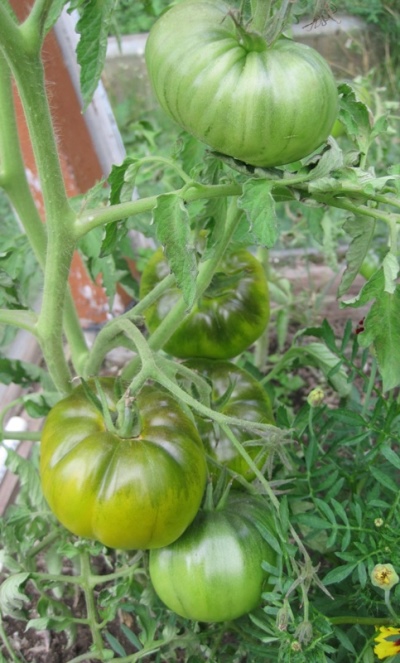
- Authors: Steinert T.V., Teplova N.S., Aliluev A.V., Avdeenko L.M., Volkova V.Yu., LLC 'Heterosis Selection'
- Year of approval: 2021
- Category: hybrid
- Growth type: determinant
- Appointment: fresh consumption
- Ripening period: early
- Ripening time, days: 115-125
- Growing conditions: for open ground, for film greenhouses
- Bush characteristic: powerful
- Leaves: medium length, dark green
The green color of a tomato does not always indicate its incomplete ripeness. There are bred varieties, the fruits of which are green and fully ripe. These tomatoes not only look unusual, but also taste quite interesting. Such vegetables are rich in chlorophyll, which boosts immunity, helps normalize metabolism, improves oxygenation of the whole body, and also increases overall tone. But such varieties also have disadvantages in the form of low yields and frequent diseases. An exception to the general rule is the Irish liqueur tomato variety, devoid of all these disadvantages.
Breeding history
The first generation hybrid Irish liqueur is the result of a completely new selection: the application for admission was registered in 2019, and entered the register already in 2021. The authors of the culture are experienced breeders T. V. Steinert, A. V. Aliluev, N. Teplova, V. Yu. Volkova, L. Avdeenko. The work was carried out on the basis of Heterosis Selection LLC.
Description of the variety
Tomato Irish Liqueur is a fruitful determinant variety that can grow and bear fruit in open field conditions, in low light, as well as in plastic greenhouses. As for the characteristics of the bush, it is quite powerful, with leaves of medium length, a dark green tint. The first intermediate inflorescence is laid after 8-9 leaves. From 3 to 5 fruits ripen in a brush. The peduncle is articulated.
The main qualities of the fruit
Irish liqueur has one peculiarity: both unripe and ripe fruits are colored green. But there is a difference - unripe tomatoes at the stalk have a dark spot, while as it ripens, the tomato becomes yellow-green, with stripes that are barely noticeable. At the same time, the fruits differ in size: their weight is from 280 to 400 g. Tomatoes are flat-round in shape, with medium-sized ribs.
Taste characteristics
Irish liqueur is a variety that has excellent, even exquisite taste, it is sweet, with a fruity aroma. Such an unusual taste and type of vegetable can inspire the preparation of an original salad or a beautiful green sauce. The tomatoes are juicy, medium soft, with a high sugar content. The high content of chlorophyll in the composition, due to the green color, has a beneficial effect on health, in addition, such fruits practically do not cause allergies compared to red tomatoes.
Ripening and fruiting
The maturation of the Irish liqueur is considered early, ranging from 115 to 125 days. Ripe fruits are harvested as soon as they are ready, which is sometimes difficult to determine, given the green color of ripe berries.
Yield
The berries of tomatoes of Irish liquor can yield a yield of 4.5–5.6 kg per sq. m.
The timing of planting seedlings and planting in the ground
It is possible to sow seeds of the considered variety for seedlings already in the first or second decade of March. Planting grown seedlings either in the ground or in a greenhouse can be carried out only after the end of frosts, which occur in spring. Typically, such work is carried out in late May or early June.

Growing tomato seedlings is an extremely important process, because it largely depends on whether the gardener will be able to harvest at all. All aspects must be taken into account, from seedbed preparation to planting in the ground.
Landing scheme
For a permanent place, tomato bushes Irish liqueur is recommended to be planted according to the scheme of 2-3 sprouts per 1 m 2.

Growing and care
When growing tomatoes Irish liqueur the recommended number of stems during formation is from 1 to 3. Watering is necessary once every 5-7 days, abundantly, one plant takes 2-2.5 liters of water. Water either early in the morning or after sunset. Loosening after watering, feeding the crop both at the stage of fruit setting and when pouring tomatoes are also important. Ripe fruits are harvested when the berries reach brown color.
When overripe, Irish Liqueur tomatoes take on an ocher and dark green color, but are not prone to cracking. Excellent yield in cool summer weather. Tomatoes of the variety should be tied up, otherwise the stems may break under the weight of large tomatoes. When pinching, unnecessary processes, as well as lower and yellow leaves, should be removed.




A plant needs different micronutrients at each stage of growth. All fertilizers can be divided into two groups: mineral and organic. Folk remedies are often used: iodine, yeast, bird droppings, eggshells.
It is important to observe the rate and period of feeding. This also applies to folk remedies and organic fertilizers.
Disease and pest resistance
The Irish liqueur hybrid was developed by experienced breeders and therefore has properties such as resistance to common tomato diseases.


Growing regions
The culture is zoned for the Northern, North-Western, as well as the Central and Volga-Vyatka regions.Tomato is also grown in the Central Black Earth Region, in the North Caucasus, the middle and lower Volga, in the Urals, in Western and Eastern Siberia, in the Far East.

























































































